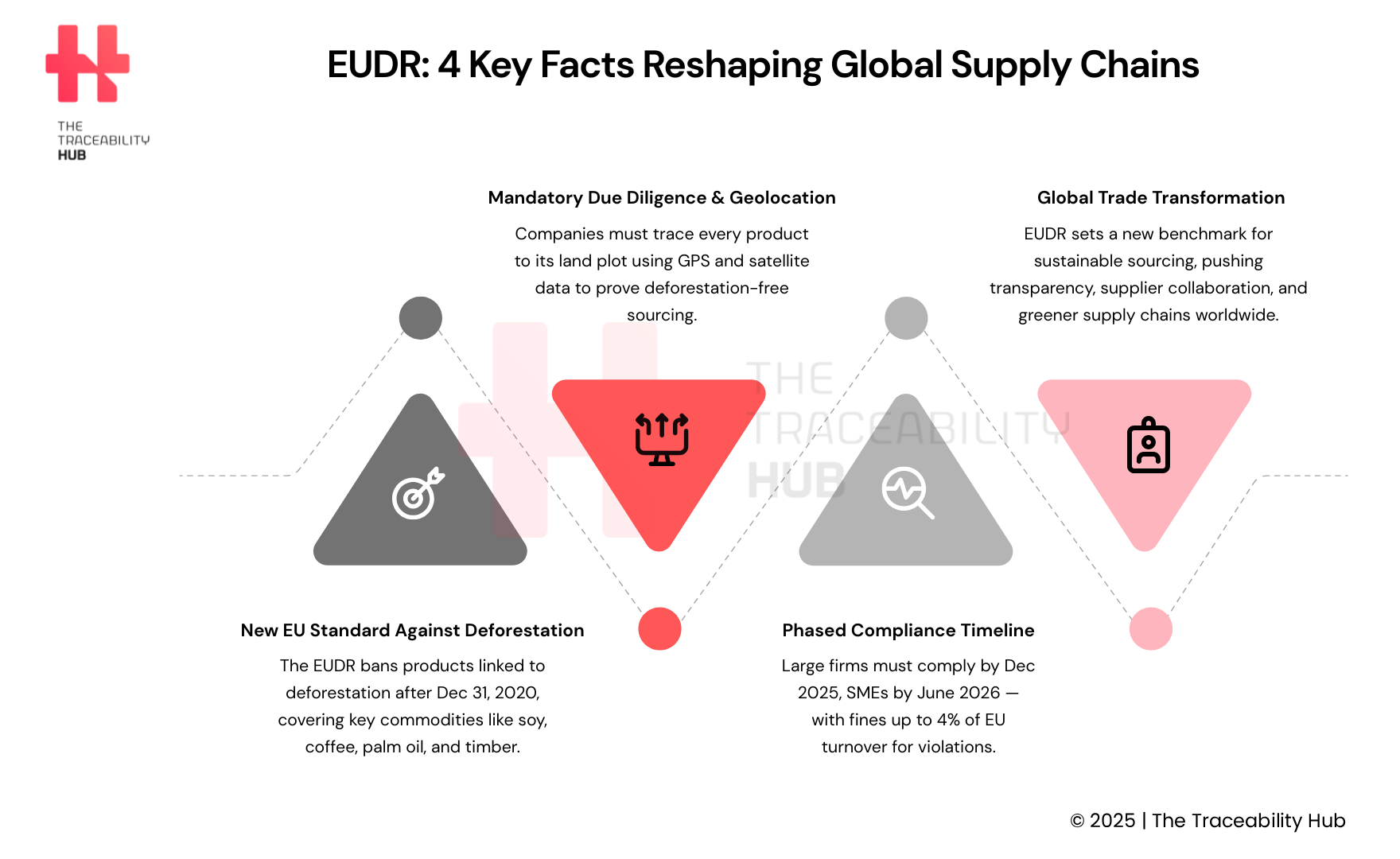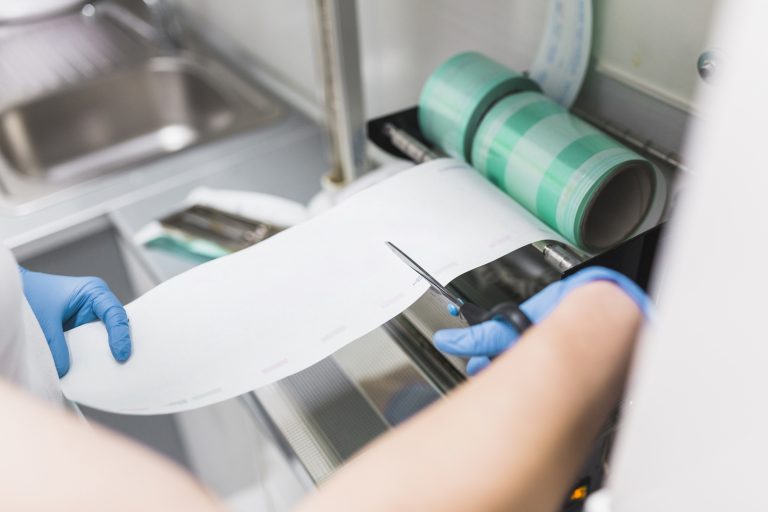Forests sustain the livelihoods of nearly one-third of people worldwide.
The EUDR, i.e. the EU Deforestation Regulation, emerged as a response to worldwide deforestation rates that continue to alarm experts. Above all only agriculture causes up to 90 percent of global deforestation: the Food and Agriculture Organization reports a staggering loss of 420 million hectares of forest in the last 30 years, surpassing the size of the European Union.
The EUDR, released in mid-2023, marks a major change in EU’s sustainability regulations that minimize deforestation from imported agricultural materials.
Large operators and traders must comply with EUDR by December 30, 2025, while smaller companies have until June 30, 2026.
This basic requirement will force companies to rebuild their existing supply networks, while this regulation sets new sustainability standards for global trade.
Companies that export affected products to EU markets need to verify their products don’t come from land deforested after December 31, 2020.
The EU believes EUDR implementation will cut greenhouse gas emissions by at least 32 million tons each year. The EU’s position as a major consumer of deforestation-linked commodities drives its mission to solve this problem and reshape global supply chains.
EUDR Regulation Timeline and Scope
The EUDR follows a clear timeline with specific milestones. The regulation came into force on June 29, 2023, and has seen several changes to its schedule.
The European Union pushed back implementation through Regulation 2024/3234, giving large and medium-sized companies until December 30, 2025, to comply. Micro and small businesses got more time, with a deadline of June 30, 2026.
Key Dates: June 2023 Entry into Force, December 2025 Applicability
Companies originally had 18 months to get ready after the EUDR’s adoption.
The European Parliament approved a 12-month extension in November 2024 after talking with stakeholders. This extra time helps businesses deal with complex supply chain tracking systems. The new rules replace and strengthen the EU Timber Regulation (EUTR), which mainly focused on stopping illegal logging.
Commodities Covered: Palm Oil, Soy, Cocoa, Timber, and More
The EUDR targets seven commodities that drive global deforestation:
- Cattle
- Cocoa
- Coffee
- Oil palm
- Rubber
- Soya
- Wood
The rules also include products listed in Annex I, such as chocolate, furniture, leather, printed paper, certain industrial fatty acids or alcohols, pneumatic tires, and various wood items.
Products must contain a commodity from Annex I and be listed there to fall under these rules. Anything made before June 29, 2023 doesn’t need to meet EUDR requirements.
Applicability to Operators, Traders, and SMEs
The rules create different categories for supply chain businesses.
“Operators” first bring products to the EU market or export them from the EU. “Traders” handle these products after they enter the market.
Both groups must follow similar rules, with responsibilities that match their role in the supply chain.
SMEs get special treatment under the EUDR: these smaller companies must meet two of three conditions: fewer than 250 employees, less than €50 million turnover, or balance sheet below €25 million. They benefit from simpler requirements and more time to comply. This approach protects the environment while giving businesses time to adapt.
Due Diligence and EUDR Compliance Requirements
EUDR compliance depends on strong due diligence procedures that operators must complete before placing commodities in the EU market. The process needs three mandatory steps: collecting information, assessing risks, and reducing risks when needed. Each supplier’s records must stay in these systems for five years from their market placement date.
Article 9: Land Use After December 31, 2020
EUDR bans products connected to deforestation or forest degradation after December 31, 2020. This cutoff date serves to measure compliance for all regulated commodities. Operators must gather “adequately conclusive and verifiable information” to show their products are deforestation-free.
The verification covers all land plots where commodities came from. Any deforestation on these plots automatically blocks all related products from entering the EU market.
Country of Production Law Compliance
Operators must prove they follow relevant laws in the country’s commodity’s production. These laws cover land use rights, environmental protection, forest management, third-party rights, labor standards, human rights, and indigenous peoples’ informed consent.
The rules also apply to tax, anti-corruption, trade, and customs regulations.
Submission via EUDR Information System
Operators need to submit due diligence statements through the EUDR Information System before market placement. This online platform stores statements and works according to Commission Implementing Regulation 2024/3084.
Each submission creates a reference number needed for customs clearance.
The system helps authorities track compliance and gives operators a well-laid-out workflow to document their supply chain clearly.
Role of Geolocation and Satellite Data
Geolocation requirements are the most technically challenging part of EUDR compliance. Operators must give exact coordinates for all production plots.
Areas larger than four hectares need polygon mapping, except for cattle.
These coordinates let authorities check satellite images to confirm no deforestation happened after the cutoff date.
EUDR Traceability Tools for Supply Chain Mapping
Digital tools have become crucial to map complex supply chains with these requirements. These solutions help collect field data, check coordinates, analyze deforestation risk, and create compliant documentation. Supply chain mapping shows products are deforestation-free and legally sourced. To name just one example, platforms can automate supplier questionnaires, handle geolocation files, and connect specific land plots to individual shipments.
EUDR 4 Key Facts Reshaping Global Supply Chains

Risk Assessment and Mitigation Strategies
Risk assessment is the foundation of EUDR implementation that helps companies identify and tackle deforestation threats in a systematic way. The regulation provides a well-laid-out framework that adjusts requirements based on where products come from.
EU Benchmarking System for Deforestation Risk
The European Commission’s standard system puts countries into three risk categories: low, standard, or high, based on how likely deforestation might occur. This classification decides how intense inspections need to be, with authorities checking 1% of shipments from low-risk countries, 3% from standard-risk countries, and 9% from high-risk regions. The assessment makes use of information from the FAO Global Forest Resources Assessment and follows objective criteria set in Article 29(3).
The system’s first review will happen in 2026, making it adaptable rather than fixed.
Simplified Due Diligence for Low-Risk Countries
Companies that source only from low-risk countries can use simplified due diligence. They still need to collect complete information, including geolocation coordinates and production data, but don’t need formal risk assessments or mitigation measures. In spite of that, they must assess their supply chain’s complexity and watch for circumvention risks. Standard due diligence procedures become mandatory if reliable information suggests non-compliance.
Mitigation Measures: Audits, Supplier Switches, Testing
Companies must put adequate mitigation measures in place until risk becomes negligible once they spot risks. Effective approaches include on-site audits, switching to verified suppliers, and satellite monitoring. Third-party checks add extra assurance, especially in areas where remote assessment isn’t enough.
Each batch needs confirmation before shipment, with full documentation of all mitigation steps.
Business Impact and Preparation Strategies
The financial impact of not complying with EUDR hits hard: companies face fines up to 4% of their yearly EU turnover. This reality changes how businesses need to handle their supply chains.
Operational Burden for Large Enterprises
Large companies face major compliance hurdles that go beyond paperwork: they need to map their whole product portfolios to spot goods that fall within scope.
This includes derived products that might not be obvious at first glance. Companies must track everything through their supply chain and keep clear records from the land plot to the final product. Operators need to gather detailed information about products, where they’re made, and exact location data from land plots. Many suppliers don’t have the tools to provide this information yet.
Segregation of Compliant vs Non-Compliant Goods
EUDR strictly bans mixing compliant and non-compliant commodities. Companies must set up separate supply chains, but many industries aren’t ready for this requirement.
The official guidance states: “Compliant commodities must be kept separate from other goods while being traded and shipped. Mixing compliant and non-compliant commodities or commodities of unknown origin is not allowed”.
When mixing happens, the EU considers the entire shipment non-compliant and blocks it from entering the market.
Support for SMEs: Reference Numbers and Phased Compliance
EUDR understands smaller companies need help and offers specific support.
Micro and small enterprises have until June 30, 2026 to comply.
These companies get simpler procedures after that date. Downstream SME operators don’t need to do due diligence if someone already submitted a statement – they just need to show the reference number when asked. SME traders also get a break – they don’t need to do due diligence or submit statements but must keep their supplier’s information.
Role of Customs and Logistics Providers in EUDR Compliance
Customs authorities play a crucial enforcement role: operators must submit a “Due Diligence Statement” and get a reference number before importing regulated products. This number needs to appear on the customs declaration. Customs can stop products at EU borders if they lack verified statements. They can also recover costs from non-compliance cases, take non-compliant goods, and stop their import, export, or marketing.
EUDR and Responsible Supply Chains
The EU Deforestation Regulation marks a turning point for global supply chains that requires unprecedented transparency from businesses worldwide. Companies must quickly adapt to these strict requirements when exporting to European markets or face heavy financial penalties. The regulation’s complete scope covers seven major commodities and many derived products that affect thousands of businesses in various sectors.
Companies should start preparing now to comply with EUDR successfully.
They need to map their supply chains right away to identify deforestation risks and set up reliable due diligence systems. Collecting geolocation data stands out as the biggest technical challenge. This requires working closely with suppliers to gather plot-level coordinates and check land-use history against the December 2020 cutoff date.
There are several tools to collect geolocation data:
- GPS-based field mapping, such as GPS devices or mobile apps to record the exact coordinates of production plots.
- Satellite-powered mapping tools, satellite imagery and remote sensing
- Digital traceability platforms, to capture, validate, and integrate geolocation data directly into DDS workflows.
- Supplier integration and training: companies must work closely with farmers, cooperatives, and suppliers to gather plot-level data.
This may involve training on mobile mapping tools or deploying field agents to assist with data collection.
Companies need clear protocols to keep compliant and non-compliant materials separate. This basic requirement might force them to rebuild their existing supply networks. The standard system makes things more complex because high-risk sourcing regions will face extra scrutiny with 9% of shipments needing inspection.
Smaller companies get more time to implement simpler requirements, though they still face major challenges to adapt. Their deadline extension to June 2026 gives them breathing room to develop their systems and processes.
EUDR wants to reshape how businesses interact with forest ecosystems worldwide. European regulators plan to remove deforestation from supply chains completely through strict enforcement and serious penalties. Companies that welcome these changes early will gain an edge while those who wait risk losing market access and damaging their reputation.
This regulation sets new sustainability standards for global trade. While it targets EU imports now, these requirements will shape international practices as suppliers adjust their operations to meet European standards.
This domino effect could speed up forest conservation efforts worldwide and create new baseline expectations for responsible sourcing in every market.
Read more: Regulatory Compliance Made Simple: From Local Rules to Global Standards






